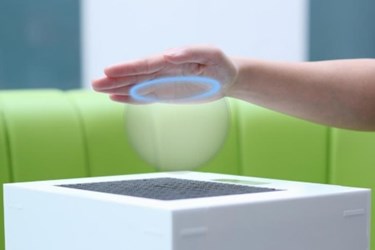Tangible Medical Imaging — CT Scans You Can Feel
By Chuck Seegert, Ph.D.

Thanks to recent advances, it may soon be possible to feel holographic images. With a new ultrasound technology, disease processes could be rendered and explored by touch in mid-air.
Haptic technology is a field of research that recreates a sense of touching something by applying forces or vibrations to a user’s senses. Often used in virtual reality applications, haptics has the potential to enhance the control of machines and devices. Special devices have been developed to convey haptic sensations, but this newest technology may now go even further.
Using ultrasonic waves, a team from the University of Bristol has developed visible haptic shapes that can be suspended in mid-air, according to a recent press release. The technology allows shapes to be felt and has significant potential in the field of medical imaging where a tumor could be rendered based on computed tomography (CT) data and then physically examined by a surgeon before operating.
Haptic shapes suspended in mid-air would eliminate the need for any actuators, wires, or physical attachments, according to a paper recently published by the team in the ACM Transactions on Graphics. Two-dimensional phased arrays of ultrasonic transducers make the sensations possible. By precisely controlling the transducers and using non-linear effects of sound, the device generates forces strong enough to be felt by the skin.
In addition to the tactile sensations, the shapes are visible due to ultrasonic disturbances in the air, according to the press release.
“In the future, people could feel holograms of objects that would not otherwise be touchable, such as feeling the differences between materials in a CT scan or understanding the shapes of artefacts in a museum,” said Dr. Ben Long, a research assistant from the Bristol Interaction and Graphics (BIG) group in the Department of Computer Science at Bristol University, in the press release.
Taking this line of thought a little further, it seems that the tactile shapes could even be used by surgeons in the operating room. Because the shapes are suspended in air and disconnected from any physical equipment, a doctor could confirm the shape of a tumor prior to performing surgery. This approach could potentially reduce dependence on 2D magnetic resonance imaging (MRI) and X-ray imaging.
The versatility of ultrasound has led to its advancement in many areas of the medical device field. Recently, a major limitation for ultrasound was overcome, as researchers developed a method to image through bone, something that previously wasn’t possible.
Image Credit: Bristol Interaction and Graphics group, University of Bristol, copyright © 2014
